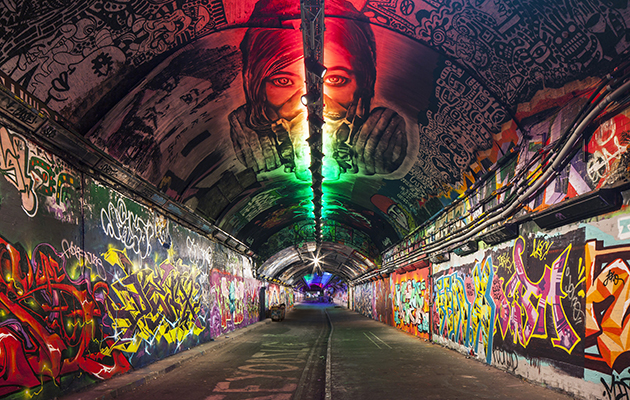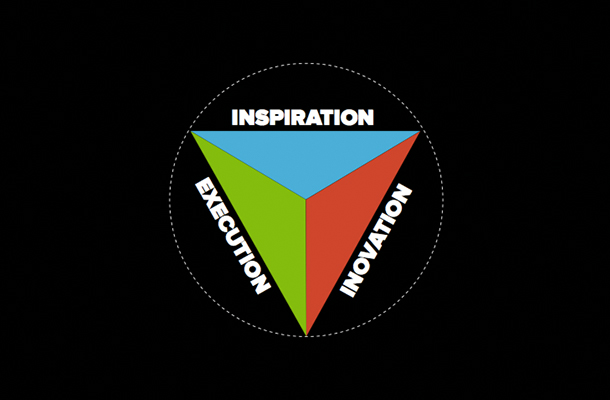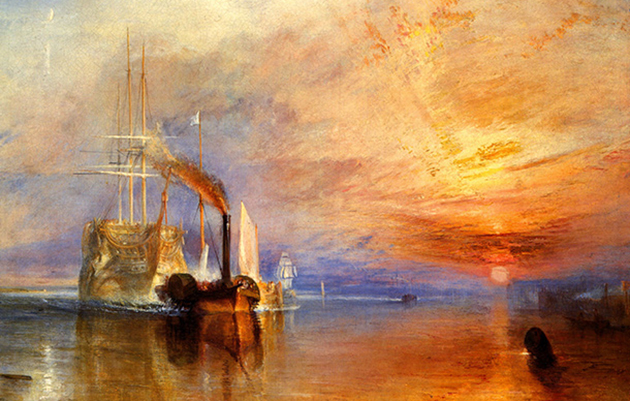 Nulty lighting in ‘Graffiti Tunnel’ in Leake Street Arches, Waterloo
Nulty lighting in ‘Graffiti Tunnel’ in Leake Street Arches, Waterloo
Guest blog: Nulty‘s Daniel Blaker looks back at ways people have found to ‘think outside the box’ and explore creativity through the ages
The expression “Thinking Sideways” was coined by a group of leading strategists and logistical thinkers during the Second World War, whose chief aim was to create a series of elaborate counter intelligence “plans-within-plans” aiming to provide as much cover for Operation Bodyguard, the Normandy D-Day landing strike, 6 June 1944, as possible. Through use of double agents, radio traffic, and visual deception this team’s approach was to not think laterally, but instead think around corners providing a carefully woven fabric of faux plans, so ornate that each collaborator could only see a few single threads of yarn, never the complete tapestry.
Included within this weave were some less orthodox approaches, including giant inflatable tanks and planes, so that from air reconnaissance it appeared that allied resources where distributed elsewhere. Another more abstract technique employed during the First and Second World War was that of “Dazzling”, where painting of warships in an almost beautifully high contrast manner was used to not mask the vessels from site, but instead confuse their profile, orientation, and direction of travel from the observer. Left field creativity like this is a key defining human characteristic framing our capacity for adaption and expression.
Creativity itself is possibly the most abstract of all commodities, with the capacity to re-interpret everything from a wholly unique perspective, challenging convention, setting new precedents, and defining new beginnings. Its significance, however, is often orthogonal to its elusiveness. So, the question is, how do we coax it out?
Many have heard of the expression “writer’s block”, a saying that, unfortunately, lends itself to any part of the creative arena. We’ve all been there when the brief is clearly defined, yet a sophisticated response evades our grasp, more often because there is our desire to not do “the standard”, but instead use each opportunity to bring about a new innovative approach that warms our creative cockles*.
Sometimes creative salvation can be found in the obvious, jumping right out at you, but in order to discover a more sensational response, exploration of the obscure is often the remedy.
There is no “one correct way” to define creative dexterity, but dexterity is perhaps the key. Important factors that influence the form of creative success can be broken down into three facets: Inspiration, Innovation, Execution. However, as with all good Venn diagrams, layering of influences is fundamental, as relying on any one avenue in isolation can lead to a rather literal response.

INSPIRATION
Inspiration can be drawn from any corner, for instance, the late great Buckminster Fuller (1895-1983), father or the Geodesic Dome, had a background in Mathematics and Philosophy. This alternative foundation liberated him to have a completely unique interpretation on the architectural form and structural processes. This distinct perspective led Buckminster to state: “You never change things by fighting the existing reality. Instead to change something build a new model that makes the existing model obsolete”. This is a very important freedom, as it reinforces that nothing is irrelevant, even the most abstract of stances may lend a unique perspective on the creative solution.
 Montreal’s geodesic dome
Montreal’s geodesic dome
Lighting, in particular, is a peculiar medium, and one with many guises. On a fundamental physical level its intrigue is boundless. Our understanding of light is a story spanning across centuries, being distilled by pioneers such as Augustin-Jean Fresnel, who in 1815 proclaimed that light travels as a wave demonstrating clear interference patterns between its wavelike “peaks and troughs”. Being further expanded upon by James Clerk Maxwell in 1864, it was stated that in fact the wave like manner that light exists actually forms part of a wider composite Electro Magnetic Spectrum, spanning from the very short wavelength (Gamma Rays ≈ 10-5nm) to the very long (Radio Waves ≈ 1m), in which our beloved visible spectrum is only a very small constituent part (circa 290nm to 800nm). Albert Einstein then dropped the proverbial physics microphone, by settling this century long debate, where in 1924, he concluded that light travels as both a particle and a wave simultaneously: the Wave-Particle Duality.
If all this wasn’t mind blowing enough, mavericks such as Niels Bohr went on to state through demonstrable science that a single photon of light, when passed through the classic wave and peak “double slit experiment” also yielded the same results, bands of both intensity and neutrality, dark and light. This means that a single photon or particle is interfering with its physical self, concluding that it must exist in two states simultaneously, until observed! This fascination with dissatisfaction and the willingness to challenge popular current thinking led us to question the very fabric of our reality. The really big stuff! Niels Bohr summed this up in a statement saying, “Everything we call real is made of things that cannot be regarded as real.”
Whilst every lighting designer is required to have a certain scientific appreciation of light, after all this knowledge forms our toolkit, our chisel and rasp as we sculpt away the darkness, we’re not only concerned with the manner in which light behaves, but also how it connects with us on an emotional level. The experience we share.
No one delicately dances with our emotional relationship with light more dexterously than James Turrell. His background in Psychology and Mathematics leads a less than direct route to an artistic interpretation of light that many would call profound. Its subtle blend and transition between how we perceive saturated colours, the “Ganzfeld Effect”, plays not only with our eyes, but also with our minds, rendering us almost boundless in space when experiencing one of his works. Turrell’s take on this sensory bathing within light led him to proclaim, “We eat light, drink it through our skin”.
Whilst the Turrells amongst us relish in the nature of light as a medium travelling through space, rolling into our eyes and our minds, other liberal and liberated thinkers, like Dan Flavin, are also interested in how this light is attained, the physical source of the light itself. Whether it’s a simple exposed bare fluorescent lamp (Dan Flavin), or the classic Artichoke Pendant (Poul Henningsen), when the illuminated environment can be directly attributed to the source it should be celebrated as a moment, an artistic endeavour in itself, creating magnificence through honesty.
As lighting designers and creatives, we need to become comfortable with being uncomfortable, and thinking around the problem, causing some waves. This will inevitably lead to a less direct path, where we have to challenge the conventions or “guidelines”, educating both the market and client to be bolder and braver. Encouraging a healthy unrest with standard practice and innovating wherever possible.
The German Philosopher, Friedrich Nietzsche, summed up freethinking very succinctly with the statement, “You have your way. I have my way. As for the right way, the correct way, and the only way, it does not exist”.
…Never just design through specification alone.
INNOVATION
The second element of our creative equilateral triangle is that of “Innovation”, in particular innovation of a product or process, enabling us a fresh freedom of application previously not available. Whether it be “Egyptian Blue”, the first recorded synthetic pigment created by its namesake, the Egyptians, circa 2500BC, or a more recent transition from the humble candle through to incandescent and fluorescent lamps, leading up to today’s carefully engineered LEDs.
All innovations open up a new arena of possibility, challenging the user to soar high into the creative rafters. However, whilst initially this box of “new tricks” can be administered liberally it may not necessarily stand the test of time. For instance, a 4500-year-old painting using Egyptian Blue would certainly be captivating based on its uniqueness alone, when it was first produced. Yet, after a while all things become passé and it’s then demanded that the creative process returns to its foundations where innovation of thought becomes just as important, if not more than the innovation of product itself.
Like it or not, as lighting designers we all sell something, even if it’s just an idea, it’s not just our passion but also our bread and butter. It’s very easy within this commercial market place to become trapped “selling design” simply through specification of the latest trend, whether it be a lovely dynamic white light solution, helping to regulate your bodies Melatonin levels, or through direct comparison of similar light sources in order to assess their quality based on latest colour rendering metrics, such as TM-30. This product awareness aspect of design is an essential part of our due diligence but has to be harmonised with creativity to support the aspirations of the design, not informing them.
EXECUTION
The third and final facet of our triangle of design is “Execution”, because everyone essentially has the same equipment at their disposal: AutoCAD, 3D Studio Max, SketchUp, the Internet…to name but a few. However, it’s only how these composite parts are assembled together that forms the framework for a lasting creative response. There are only so many notes. It’s how they’re arranged that forms a great symphony. So, to this end execution is the final part of a captivating creative response.
An example of precision execution in action is that of the artist Jackson Pollock (1912-1956), as at first glance his work in abstract expressionism can appear to be ad-hoc and uncontrolled. However, this is far from the truth, because each “splatter” and “strike” of paint had a very definite destination, bringing a contrived balance to each piece that’s unassuming but apparent.
Another great artist with a very evident use of lighting was Caravaggio (1571-1610), who within his style of renaissance art appeared to have a very considered theatrical approach to the use of lighting. Paying key attention to the directionality of light expressing only key forms within each scene, revealing only what’s required.
The execution in portrayal of lighting within art however is not solely about the more rigid properties of the renaissance-like realism. As mentioned before, our emotional response can also be exploited to communicate or make a statement. Such an artist who celebrated this “looseness” of expression in its more emotive form was JMW Turner (1775-1851). With an exquisite luminosity to his use of lighting, Turner’s ability to literally capture emotion within the air of his paintings is like no other, leading him to be given the title, “The painter of light”.
 Turner’s The Fighting Temeraire, completed in 1838
Turner’s The Fighting Temeraire, completed in 1838
Stepping through time and form into the third dimension we can also look at the sculptural forms produced by Antony Gormley, who has a characteristic style where the relationship between the human form, living and abstract, sit within time and space, with natural tones to provide context for his “body” of work.
All these great artists have one thing in common and that’s consideration for the statement being made, or at least explored. In order to extract an emotional response from the observer, with almost surgical precision, requires a great deal of consideration to ensure success.
As lighting designers, we’re blessed with the opportunity to craft something unique each time we work on a new scheme, more often whilst dealing with the demands of the client, and wider design team. This can sometimes help set the brief but can also throw up new challenges and restrictions that need to be adhered to. Unless you’re ‘briefless’, and a completely unhindered lighting artist flying free from the shackles of CDM reports and watts per square meter targets.
In order to define what creativity is and the best process that leads us to this end, there’s no definitive summary. The abstract nature of creativity is also its beauty, meaning that whilst you can inform it, learning from legends, peers, text books, product catalogues, mistakes etc, you’re also relying on that moment of serendipity for inspiration. Safe in the knowledge that this will probably not come from the obvious place. At least that holds true of the best ideas.
Daniel Blaker is the Creative Director at Nulty Lighting.

















